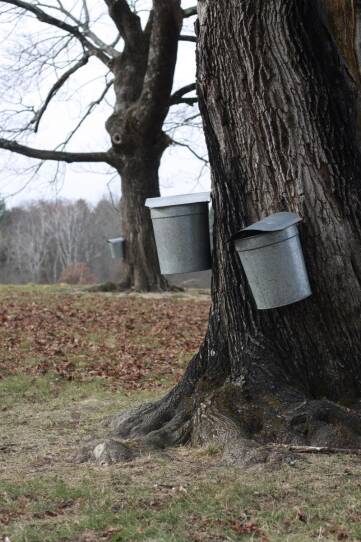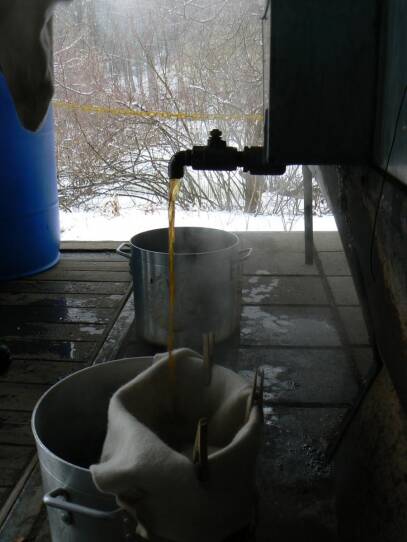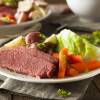As a kid, I loved to read the Little House on the Prairie books. One of my favorite chapters included a whimsical description of the maple sugaring process. I remember pestering my mom about tapping the maple trees in our suburban New York backyard, only to find out there weren’t any. Undeterred, I quickly recovered from my disappointment by suggesting we fill a cake pan with what snow remained on our patchy winter lawn, then top it with maple syrup as a treat, just like little Laura Ingalls Wilder had done. Slightly horrified at the thought of me gulping down a plateful of dirty snow for dessert, my mother encouraged me to stay indoors and snack on something else. I promptly forgot my quest to recreate the scene in the book, and that was that. Little did we know that further north, in parts of New England, eating “sugar on snow” is a welcome tradition.
During sugaring season, maple syrup is boiled down and drizzled over fresh packed snow or shaved ice in order to transform it into a stringy, taffy-like consistency. To mitigate the sweetness, it’s often served with a strong cup of coffee, a plain donut and a dill pickle, known in Vermont as a “sugar on snow supper.” Some people prefer to boil the syrup down to a luscious maple cream and scoop it up by the spoonful, or pour it into molds to make melt-in-your mouth candy. Whether it’s frothed into a latte, churned into ice cream, or slathered over chicken and waffles, Americans have long enjoyed the rich amber goodness of New England maple products.
A sweet New England history
In the first half of the 17th century, cane sugar was a highly prized and extremely expensive commodity. So, when the Pilgrims and Puritans set sail for the New World, they brought beehives with them to produce honey as an economical alternative. Back then, sugar maples were abundant in northern New England, and it is said that the Abenaki tribe traded maple sugar with the English colonists and taught them how to make it. In addition to tending bees for honey, the colonists wholeheartedly took to tapping maple trees for their sweet sap. By the 1750s, nearly every farm in New England was producing hundreds of pounds of maple sugar per year as an off-season cash crop. Farmers often produced enough to supply their own family and sold the remainder to big city markets like Boston.

It was around this time, in the 18th century, that the different grades of maple syrup were established. The paler “fancy” grade was considered most desirable because it had the most neutral flavor in comparison to cane sugar. More than just a sweetener, maple sugar became a product with ideological significance. Between the American Revolution and the Civil War, New Englanders who supported the abolitionist movement advocated its use over cane sugar, labeling it an “antislavery alternative.” But by the 19th century, cane sugar dominated the market and maple syrup gradually became a luxury item. It still is; as of 2014, the average price per gallon was estimated at around $36 — ouch!
Maple syrup DIY
If you’re seeking a cheaper, more direct way to get your maple fix, look no further than your own backyard. Even if you don’t have trees you can tap on your property, if you live in New England, it’s likely someone in your neighborhood does — just make sure to get their permission before you tap them. To learn how to do it, I recommend taking a backyard maple sugaring class like the one I recently attended through Mass Audubon . You’ll learn which types of maple trees you can tap (there are four: Norway, Red, Silver and Sugar), how to identify them, what equipment to use, and how to collect the sap, store it, filter it, and turn it into syrup.
Tia Pinney, a naturalist and instructor at Drumlin Farm and Wildlife Sanctuary , remembers making maple syrup in her grandmother’s kitchen when she was a child; the boiling sap generated so much steam, it made the edges of the wallpaper curl. Unsurprisingly, Pinney recommends making syrup outdoors, especially when dealing with large quantities. It’s best to boil the sap continuously in a metal container with a large surface area so it evaporates more quickly. To eliminate too much foaming, you can stick a knife in butter and then stick it in the boiling liquid to break the surface tension. Some people prefer to stick a hot dog or sausage in the syrup as it boils to accomplish the same thing, and then eat the maple-soaked meat once it’s cooked through. Other sugaring tips include: tapping the tree under a large branch to get the best flow; storing sap at 38 degrees or cooler to prevent it from spoiling; and wetting the felted wool filter prior to pouring the syrup through, so the syrup filters rather than getting absorbed.

While a yard full of trees hung with silver collection buckets may sound quaint, be forewarned — backyard maple sugaring is a venture that’s not to be taken lightly. To produce just one gallon of syrup, it takes at least 45 gallons of raw sap. One tap may produce 3-5 gallons of it on a good day, so collection buckets should be checked and emptied regularly (depending on your setup, this could mean daily). You’ll need a place to store the sap until you’re ready to boil it down into syrup, which is a time-consuming process that requires close attention. If all of that sounds like too much of a commitment, you may prefer to see how it’s done at a local sugarhouse during Massachusetts maple weekend in March. But if you’re sufficiently prepared, backyard sugaring is a rewarding activity the whole family can do together, right at home. It’s a way to connect with the rhythm of the seasons, and even to local history. And if the opportunity to make sugar on snow presents itself, take it and enjoy it — just remember to use clean snow.
Visit
MassMaple.org
for more information on local maple syrup production. Follow Amanda on Twitter
@amandabalagur
.




